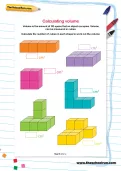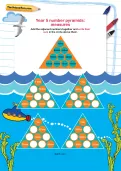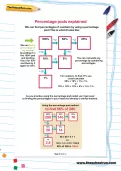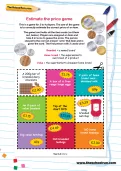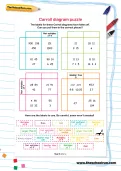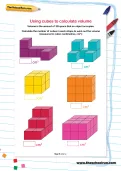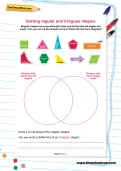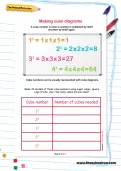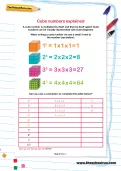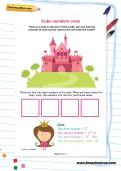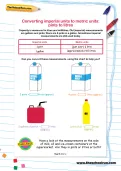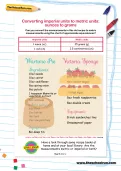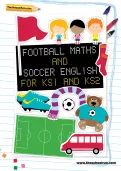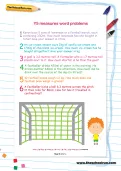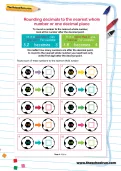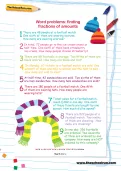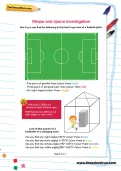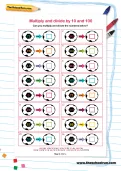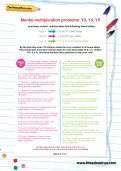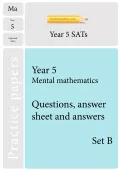Year 5 Maths worksheets
Free worksheets: Weights and measurements, KS2, Y5
You’ll need to login or Register first to access these worksheets for free.
Once you’ve tried out our free worksheets, why not explore all our resources (1000s of worksheets, interactive tutorials, learning packs and more) with a 14-day FREE trial subscription.
Calculating perimeters
A Year 5 and 6 printable worksheet created by an experienced teacher to help your child practise calculating perimeters.
To find the perimeter of a shape you must add up the lengths of each of the sides. Can your child calculate the perimeters of these common shapes?
To find the perimeter of a shape you must add up the lengths of each of the sides. Can your child calculate the perimeters of these common shapes?
Calculating volume
Volume is the amount of 3D space that an object occupies. Volume can be measured in cubes. Calculate the number of cubes in each shape to work out the volume.
Year 5 number pyramids: measures
Add the adjacent numbers together and write their sum in the circle above them.
Percentage pods explained
We can find percentages of numbers by using a percentage pod! As you practise using the percentage pod model you’ll get used to finding the percentages in your head and develop a mental method.
Estimate the price game
This is a game for 2 to 4 players. The aim of the game is to correctly estimate the correct price of an item. The game host holds all the item cards. Players are assigned an item and take it in turns to guess the price. The person closest to the correct answer ‘wins’ that item and is given the card. The first person with 3 cards wins!
Carroll diagram puzzle
The labels for these Carroll diagrams have fallen off. Can you put them in the correct places?
Using cubes to calculate volume
Volume is the amount of 3D space that an object occupies. Calculate the number of cubes in each shape to work out the volume (measured in cubic centimetres, cm3).
Sorting regular and irregular shapes
Regular shapes have equal-length sides and all the internal angles are equal. Can you cut out the shapes and sort them into the Venn diagram? Then draw a circle around the regular shapes and write a definition of an irregular shape.
Regular and irregular shapes four in a row
Have fun with irregular shapes with this four-in-a-row game.
Making cube diagrams
A cube number is when a number is multiplied by itself and then by itself again. Cube numbers can be visually represented with cube diagrams. Make 3D models of these cube numbers using sugar cubes, square Lego bricks, clay. How many cubes did you need?
Cube numbers explained
A cube number is multiplied by itself and then by itself again! Cube numbers can be visually represented with cube diagrams. When writing a cube number we use a small 3 next to the number. Can you use a calculator to complete the table below?
Cube numbers code
There is a code on the door of the castle. Can you help the princess to work out the code so she can enter the castle?
Converting imperial units to metric units: pints to litres
Capacity is measured in litres and millilitres. Old (imperial) measurements are gallons and pints; there are 8 pints in a gallon. Sometimes imperial measurements are still used today. Can you convert these measurements, using the chart to help you?
Converting measurements
Can you convert the measurements in this old recipe to metric measurements using the chart of approximate equivalences?
Calculating volume
Volume is the amount of 3D space that an object occupies. Volume can be measured in cubes. Calculate the number of cubes in each shape to work out the volume.
Football maths and soccer English for KS1 and KS2
Make the most of World Cup fever and give grammar, division and spelling practice a football twist with our soccer-themed worksheets for KS1 and KS2 children.
Y5 measures word problems
Can you work out the answers to these tricky word problems all about measurements?
Rounding decimals to the nearest whole number or one decimal place
A Year 5 maths worksheet created by an education expert that will help your child round decimals to the nearest whole number or one decimal place - with a football theme.
Word problems: Finding fractions of numbers
Read these word problems and see if you can answer them – you'll need to use your fractions skills.
Shape and space investigation
See if you can find the parallel and perpendicular lines and right angles in this bird’s eye view of a football pitch.
Mental multiplication problems: Y3, Y4, Y5
A teacher-made maths worksheet on mental multiplication problems for Year 3, Year 4 and Year 5 children with a football theme.
By the time they enter Year 5 children should be very confident in all times tables. They should also know their division facts for each times table (if 6 x 3 = 18 then 18 ÷ 6 = 3). Use these mental maths questions to test your child.
By the time they enter Year 5 children should be very confident in all times tables. They should also know their division facts for each times table (if 6 x 3 = 18 then 18 ÷ 6 = 3). Use these mental maths questions to test your child.
Optional SATs papers: Y5 maths set B
Written by a primary-school teacher to mirror the optional SATs papers used in schools prior to 2015 to assess pupils' progress at the end of the school year, this is a Year 5 maths mock optional SATs paper. TheSchoolRun optional SATs practice papers are exclusively available to subscribers.

